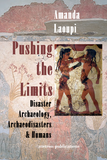They were all humans...
From: Amanda Laoupi's Pushing the Limits

Amanda Laoupi’s PUSHING THE LIMITS is a gold mine for researchers trying to unravel myriads of un-solved enigmas in natural and human history.
Gunnar Heinsohn (August 2016)
Read from Amanda Laoupi's book...
Disaster Anthropology
Our ancestors lived in highly active volcanic environments since the Lower Pleistocene. Generally speaking, there are more than 60 ancient hominid track sites, ranging in age from 3.7 Ma to less than 2.5 Ka, recorded from all continents except Antarctica, but no ichnotaxonomic names have ever been formally proposed for hominid tracks. Unfortunately, the hominid track site sample includes only about a dozen sites where footprint preservation is good enough to show details of diagnostic foot morphology and typical track way morphology (Grattan and Torrence, 2007; Kim, et al, 2008).
Three and a half million years ago (geologic dating), in a location now known as Tanzania, the Sadiman palaeovolcano erupted, covering the area with ash (Zaitsev, et all, 2011). The rain that followed the event created a natural type of cement which fossilized the footprints of any species that may have walked over the wet ash (Agnew, Demas and Leakey, 1996). One of these species happened to be a hominid. The Laetoli track way was discovered in volcanic ash sediments. This fossilized footprint pattern indicated that the animal was a bipedal animal, turning this evidence into a tremendous discovery, which uncovered when, in hominid history, our ancestors began walking on two legs. Fossils of the hominid Australopithecus afarensis dating to 3.8 to 3.6 Ma were found in the surrounding areas, thus the scientists were able to identify these tracks. Scientists have also found even more evidence for bipedalism in A. afarensis, because he had a special anatomy of the shin bone that indicated an upright posture. Unfortunately, these footprints are in danger of being destroyed, although they represent the earliest direct evidence of kinetically hominin bipedalism, showing that extended limb bipedalism evolved long before the appearance of the genus Homo. Since extended-limb bipedalism is more energetically economical than ape-like bipedalism, energy expenditure was likely an important selection pressure on hominin bipeds by 3.6 Ma (Raichlen, et al, 2010; for other footsteps of Pleistocene era, see also Bennett, et al., 2009 and Ashton, et al., 2014).
Humans also left tracks (20 cm each) in the volcanic ash of the Roccamonfina volcano of Southern Italy (41.3 N, 14.9 E), initially dated between 385-325 Ka, but with a refined 40 Ar/39 Ar technique, at 348-340 Ka. Just to the north of the city of Naples, in the province of Caserta, is the Roccamonfina Regional Park, the most prominent part of which is the Roccamonfina volcano, the oldest volcanic complex in the Campania region of Italy. It had three main eruptive periods: (1) 630-400 Ka; (2) 385 and 230 Ka; (3) a period that ended in 50 Ka, just as the better known eruptions to the South (e.g. the Archiflegrean caldera and, later, Mt. Vesuvius) were about to start. There are 56 such impressions on the slopes of the volcano; they were footprints made during its second eruptive period. The prints display raised arches and ball and heel impressions; they were left by a small band of individuals, from 3 to 6 persons. The prints and length of stride indicate that they were under five-feet tall...
Read more about Pushing the Limits
Amanda Laoupi: biography
Amanda Laoupi was born in Athens on August 19, 1968. She studied at the National and Kapodistrian University in Athens. She has a PhD in Environmental Archaeology (Summa Cum Laude) and has done post-doctoral work in Earth Sciences and Environmental Studies. She has an MSc in Environmental Protection and Management. She has worked for the Goulandris Museum of Natural History and for the National Technical University of Athens (NTUA) - Centre for the Assessment of Natural Hazards and Proactive Planning as an associate researcher
She is the founder of the interdisciplinary scientific field of Disaster Archaeology (2005), the founder and webmaster of websites on Archaeodisasters (2010). She has a rich online presence and has collaborated with a plethora of institutions, researchers and clients in a variety of topics
Environmental & Cultural Sectors:
Crisis & Disaster Studies, Hazard Heritage Management, Creative Industries & Digital Humanities, Environmental Education, Academic Research; Public & Private Consulting; Archaeodisaster & Spiritual Tourism; Matriarchal Studies.

